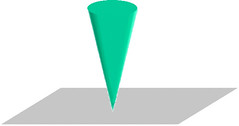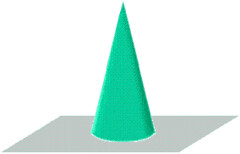Conditions for the Equilibrium
Conditions for the Equilibrium of Three Non-Parallel Forces
If we say that an object is under the influence of forces which are in equilibrium, we mean that the object is not accelerating – there is no net force acting.The object may still be travelling but at a constant velocity
| i) | The lines of action of the three forces must all pass through the same point. |
| ii) | The principle of moments: the sum of all the clock-wise moments about any point must have the same magnitude as the sum of all the anti-clockwise moments about the same point. |
| iii) |
a) The sum of all the forces acting vertically upwards must have the same magnitude as the sum of all the forces acting vertically downwards |
Lami’s theorem states that if three forces acting at a point are in equilibrium, each force is proportional to the sine of the angle between the other two forces.
Consider three forces A, B, C acting on a particle or rigid body making angles α, β and γ with each other.
According to Lami’s theorem, the particle shall be in equilibrium if



A cone cannot be made to stand on its tip. Theoretically, this feat might be possible if the cone could be placed with its center of gravity exactly in a vertical line through through the tip.
The cone would then be in equilibrium under the action of the force of gravity on it acting downwards and an equal and opposite reaction to its weight exerted on it by the table. But even if this condition could be achieved momentarily, the slightest vibration of the draught would inevitably cause the cone to tilt.
The force of gravity, W, would then exert a turning force about the tip, and this would cause the cone to topple over. A cone placed on its tip is said to be in unstable equilibrium.

The image shows the cone standing on its base. If tilted from this position, even through a fairly large angle, the vertical line through the center of gravity, G, will still fall inside the base.
Consequently, the force of gravity on the cone will have a moment W × x about an edge of the base which will pull the cone back into its original position.
Under these conditions, it is not easy to knock the cone over, and it is said to be in stable equilibrium.

Now, the cone is lying on its side. the base is simply a straight line, and if the cone is rolled into a new position the vertical line through the center of gravity still continues to pass through exactly the same point in the base.
Whatever the position of the cone, the reaction from the table will act in the same straight line as the force of gravity through G, and so the cone will be in equilibrium. The force of gravity exerts no moment about the base as axis and, if displaced, the cone will therefore remain at rest in its new position. This condition is described as neutral equilibrium.
It should be clear from the above explanation that the stability of a body depends on the direction of the turning moment exerted by the force of gravity on the body about the edge of the base, when the body is given a small displacement.
If a small displacement brings the vertical through the center of gravity outside the base the body will be unstable. If, however, the vertical remains within the base the body will be stable.
When a displacement causes no change in the position of the vertical through the center of gravity with respect to the base the body is in neutral equilibrium.
